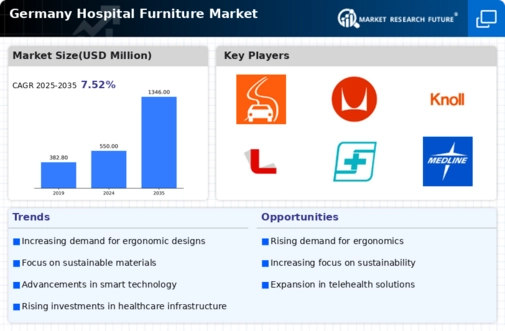The hospital furniture market in Germany is characterized by a competitive landscape that is increasingly shaped by innovation, strategic partnerships, and a focus on sustainability. Key players such as Hill-Rom (US), Stryker (US), and Arjo (SE) are actively pursuing strategies that enhance their market positioning. Hill-Rom (US) emphasizes technological advancements in patient care solutions, while Stryker (US) focuses on expanding its product portfolio through acquisitions and innovative designs. Arjo (SE) is concentrating on enhancing patient mobility solutions, which reflects a broader trend towards improving patient outcomes. Collectively, these strategies contribute to a dynamic competitive environment where differentiation is increasingly based on technological innovation and service quality.
In terms of business tactics, companies are localizing manufacturing to reduce lead times and optimize supply chains, which is particularly relevant in the context of rising operational costs. The market structure appears moderately fragmented, with several players vying for market share. However, the influence of major companies is significant, as they set benchmarks for quality and innovation that smaller firms often strive to meet. This competitive structure fosters an environment where collaboration and strategic alliances are becoming more common, as companies seek to leverage each other's strengths.
In October 2025, Stryker (US) announced the launch of a new line of ergonomic hospital beds designed to enhance patient comfort and staff efficiency. This strategic move is likely to strengthen Stryker's position in the market by addressing the growing demand for products that improve both patient care and operational efficiency. The introduction of these beds aligns with the company's broader strategy of integrating advanced technology into its offerings, thereby enhancing its competitive edge.
In September 2025, Hill-Rom (US) entered into a partnership with a leading telehealth provider to integrate remote monitoring capabilities into its hospital furniture solutions. This collaboration is indicative of a trend towards digital transformation in healthcare, where the integration of technology into traditional products is becoming essential. By enhancing its product offerings with telehealth capabilities, Hill-Rom (US) positions itself as a forward-thinking leader in the market, potentially attracting healthcare facilities looking to modernize their operations.
In November 2025, Arjo (SE) unveiled a new sustainability initiative aimed at reducing the environmental impact of its manufacturing processes. This initiative includes the use of recycled materials in its products and a commitment to reducing carbon emissions by 30% over the next five years. Such moves not only align with global sustainability trends but also resonate with healthcare providers increasingly focused on environmentally responsible practices. Arjo's proactive approach may enhance its brand reputation and appeal to a growing segment of eco-conscious customers.
As of November 2025, the competitive trends in the hospital furniture market are increasingly defined by digitalization, sustainability, and the integration of artificial intelligence (AI) into product offerings. Strategic alliances are shaping the landscape, allowing companies to pool resources and expertise to drive innovation. The shift from price-based competition to a focus on technology, quality, and supply chain reliability is evident. Moving forward, competitive differentiation will likely hinge on the ability to innovate and adapt to changing market demands, with companies that prioritize these aspects poised to lead the market.

















Leave a Comment